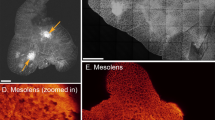Abstract
This manuscript offers an image presentation of diverse forms of Borrelia burgdorferi spirochetes which are not spiral or corkscrew shaped. Explanations are offered to justify the legitimacy of tissue forms of Borrelia which may confuse the inexperienced microscopic examiner and which may lead to the misdiagnosis of non-spiral forms as artifacts. Images from the author’s personal collection of Borrelia burgdorferi images and a few select images of Borrelia burgdorferi from the peer-reviewed published literature are presented. A commentary justifying each of the image profiles and a survey of the imaging modalities utilized provides the reader with a frame of reference. Regularly spiraled Borrelia are rarely seen in solid tissues. A variety of straightened, undulating, and clipped-off profiles are demonstrated, and the structural basis for each image is explained. Tissue examination is a diagnostic tool and a quality control for judging the eradication or the persistence of borreliosis following attempts to eradicate the infection with antibiotic therapy. The presence or absence of chronic Lyme borreliosis may be objectively adjudicated by tissue examinations which demonstrate or which fail to show pathogenic microbes in patients who have received a full course of antibiotics.












Similar content being viewed by others
References
Burgdorfer W, Barbour AG, Hayes SF, Benach JL, Grunwaldt E, Davis JP (1982) Lyme disease—a tick-borne spirochetosis? Science 216(4552):1317–1319. doi:10.1126/science.7043737
Burgdorfer W, Barbour AG, Hayes SF, Péter O, Aeschlimann A (1983) Erythema chronicum migrans—a tickborne spirochetosis. Acta Trop 40(1):70–83, PMD 6134457
Burgdorfer W (1984) Discovery of the Lyme disease spirochete and its relation to tick vectors. Yale J Biol Med 57(4):515–520, PMCID 2590008
Embers ME, Barthold SW, Borda JT, Bowers L, Doyle L, Hodzic E et al (2012) Persistence of Borrelia burgdorferi in rhesus macaques following antibiotic treatment of disseminated infection. PLoS One 7(1):e29914. doi:10.1371/journal.pone.0029914
Barbour AG, Hayes SF, Heiland RA, Schrumpf ME, Tessier SL (1986) A Borrelia-specific monoclonal antibody binds to a flagellar epitope. Infect Immun 52(2):549–554, PMCID 261035
MacDonald AB (1989) Gestational Lyme borreliosis. Implications for the fetus. Rheum Dis Clin North Am 15(4):657–677, PMD 2685924
Sadziene A, Thomas DD, Bundoc VG, Holt SC, Barbour AG (1991) A flagella-less mutant of Borrelia burgdorferi. Structural, molecular, and in vitro functional characterization. J Clin Invest 88(1):82–92
Sartakova ML, Elena Y, Dobrikova M, Motaleb MA, Godfrey HP, Charon NW, Cabello FC (2001) Complementation of a nonmotile flaB mutant of Borrelia burgdorferi by chromosomal integration of a plasmid containing a wild-type flaB allele. J Bacteriol 183(22):6658–6564, PMCID 95486
Berger BW, Clemmensen OJ, Ackerman AB (1983) Lyme disease is a spirochetosis. A review of the disease and evidence for its cause. Am J Dermatopathol 5(2):111–124, PMID 6410931
Eisendle K, Grabner T, Zelger B (2007) Focus floating microscopy: “gold standard” for cutaneous borreliosis? Am J Clin Pathol 127(2):213–222, PMID 1721053
Hammer B, Moter A, Kahl O, Alberti G, Göbel UB (2001) Visualization of Borrelia burgdorferi sensu lato by fluorescence in situ hybridization (FISH) on whole-body sections of Ixodes ricinus ticks and gerbil skin biopsies. Microbiology 147(Pt 6):1425–1436, PMID 11390674
Eshoo MW, Crowder CC, Rebman AW, Rounds MA, Matthews HE, Picuri JM et al (2012) Direct molecular detection and genotyping of Borrelia burgdorferi from whole blood of patients with early Lyme disease. PLoS One 7(5):e36825. doi:10.1371/journal.pone.0036825
Acknowledgments
Financial support for this research was provided by a grant from the Tick Borne Disease Alliance (TBDA),244 Fifth Avenue,Suite 1450,New York, New York, 10001, USA.Tel: +1-646-4504882. Fax: +1-914-9677744.
Conflict of interest
The author declares that he has no conflict of interest.
Author information
Authors and Affiliations
Corresponding author
Rights and permissions
About this article
Cite this article
MacDonald, A.B. Borrelia burgdorferi tissue morphologies and imaging methodologies. Eur J Clin Microbiol Infect Dis 32, 1077–1082 (2013). https://doi.org/10.1007/s10096-013-1853-5
Received:
Accepted:
Published:
Issue Date:
DOI: https://doi.org/10.1007/s10096-013-1853-5




